How to make Manhattan-style Fermented Pickles with Garlic and Dill! An easy step-by-step guide to making the most flavorful, crunchy, tangy pickles full of healthy probiotics with only 20 minutes of hands-on time! The pickle brine is like a “tonic” -drink a shot daily to support a healthy gut! Video.
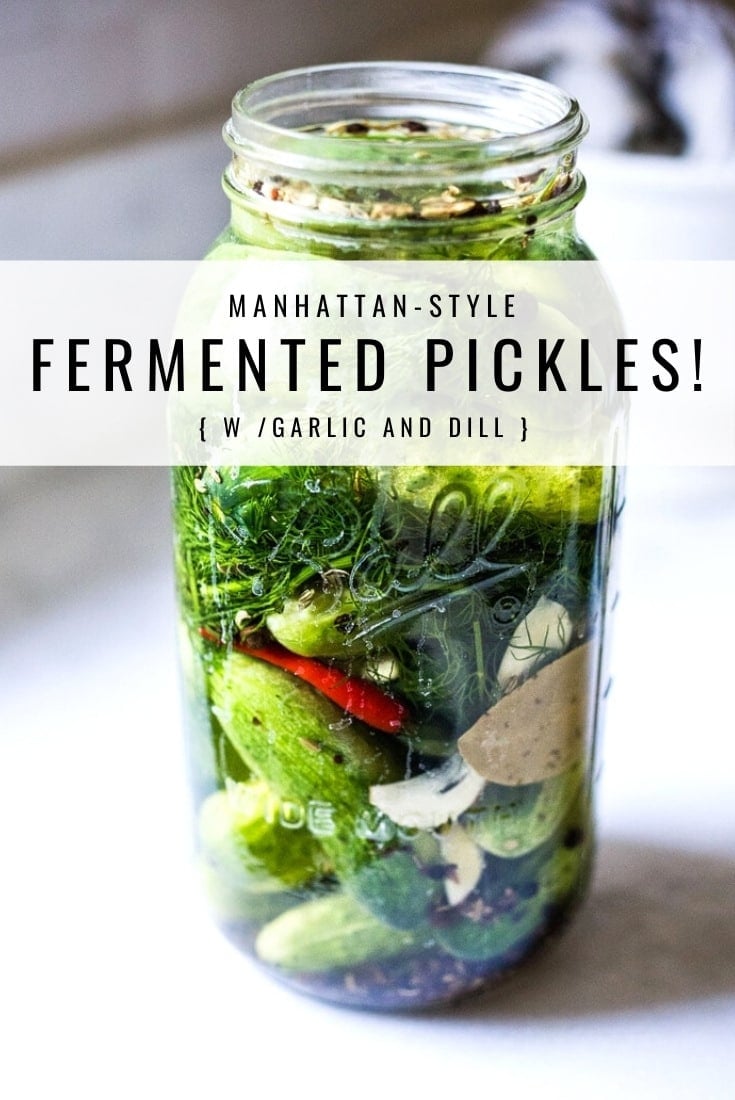
What happens when people open their hearts? They get better. ~Haruki Murakami
I’m excited to share this easy recipe for Fermented Pickles with you! If you are a crunchy pickle lover like me, you will be in heaven. Seriously, these are the best! These Manhattan-style “half-sour” fermented dill pickles are crispy, crunchy, flavorful, and oh-so alive!
Fermented in a salt brine, rather than vinegar, they get their delicious tanginess from light fermentation rather than vinegar.
Full of healthy, gut-healing, immunity-boosting probiotics these little guys are perfect as a low-calorie snack, or sliced and added to sandwiches or served as a tasty side.
Not only are they delicious and incredibly EASY to make, they are also incredibly good for us!
And as crazy as this may sound to some, the fizzy brine itself is like a healing tonic to me – I love to drink a shot of it- especially when I feel like my immunity needs a boost! So flavorful and totally energizing. Or try a Gin and Brine!
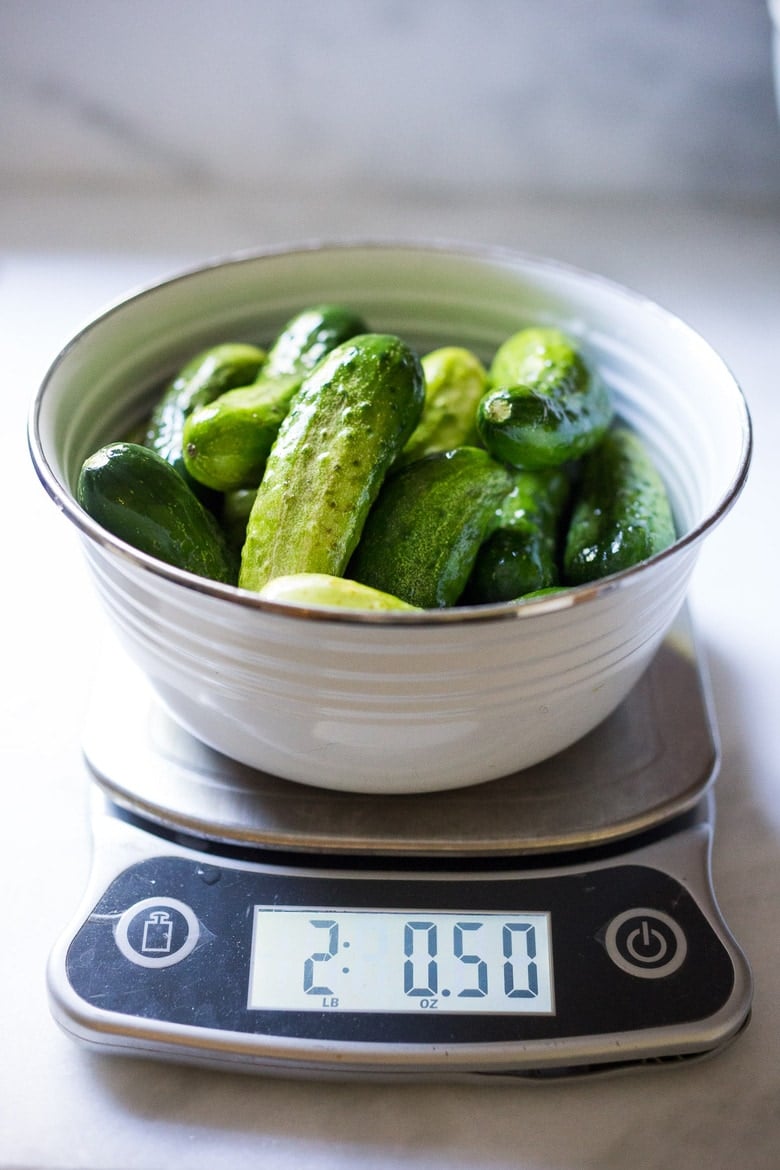
What you’ll need
- Pickling Cucumbers- Small and short (4 inches long) with thin bumpy skin, crisp texture, small seeds, a blocky shape and color gradient from light to dark. Varieties include Kirby, Calypso, Royal, Pickalot, National Picking, Adam Gherkin, Sassy, Eurika, Jackson, Boston Pickling, Northern Pickling… to name a few. You’ll need 2 lbs of “pickling cucumbers.” This recipe makes one large 1/2 gallon jar (or use two quart-sized jars) – a relatively small batch. Pickling cucumbers are most easily found at your local farmers’ market. Ask the farmers if they have “pickling cucumbers” they can help direct you to the right ones. Your pickles will only be as good as your cucumbers, so choose wisely! Make sure they are roughly the same size -about 4 inches long with 1 1/2-inch to 2-inch diameters – so they fit in the jar nicely and ferment at the same rate. I handpicked each one. They should be fresh and crisp with no soft spots.
- Salt-use fine sea salt, or fine Himalayan Pink salt
- Garlic and Onion – we load this up with 10-20 garlic cloves for the best flavor!
- Fresh Dill – use a big handful!
- Spices: Ground Turmeric ( adds fresh flavor) fennel seeds, mustard seeds, whole peppercorns, coriander seeds, whole allspice, dill seeds and celery seeds. Feel free to change or embellish! I added a couple of chilies for a little heat.
- Optional Tannic Acid: Bay leaves, grape leaves, oak leaves, or a couple of slices of fresh horseradish root. Cucumbers contain enzymes that soften them. To prevent this add a few bay leaves or a grape leaf to the jar.
- Two-Quart Mason Jar ( 8 cup mason jar)
- Fermentation weights
- Optional: Air lock, gasket, metal ring
How long does it take to ferment pickles?
These 3% Brined, half-sour crunchy pickles take 3-5 days of fermenting time.
The Brine: SALT TO WATER RATIO
- This recipe is a 3% salt water brine, which is considered “safe”. It equals 7 grams of salt per 1 cup of water. Or, 1 heaping teaspoon salt (1 1/4 teaspoon salt ) per 1 cup of water. This ratio allows one to drink the brine (like a shot) because it is not too salty and is designed for a shorter fermentation period ( 3-5 days). Crunchy, lightly fermented pickles!
- If you want a stronger brine for a longer ferment, feel free to go up to 4.5%. So for example, 3.5% Ratio= 9 grams of salt per 1 cup of water, 4.5% brine =10.8 grams of salt per 1 cup of water. For a 4.5% brine, half-sour pickles take 5-7 days, full sour pickles 14-21 days.
Fermented Pickles (step-by-step Instructions)
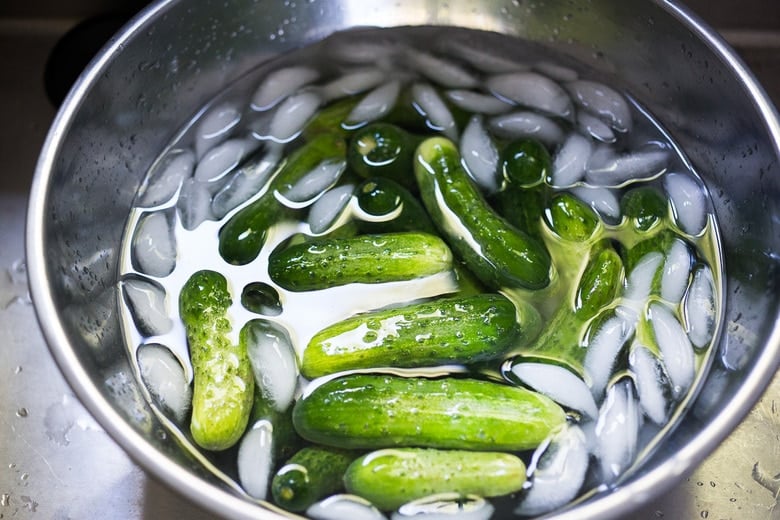
Step 1: Wash the cucumbers, slice off 1/16 inch of the blossom end, and soak them in an ice bath for 15-30 minutes to firm and crisp them up. There are enzymes in the blossom end that can make your pickles soft, so be sure to remove them.
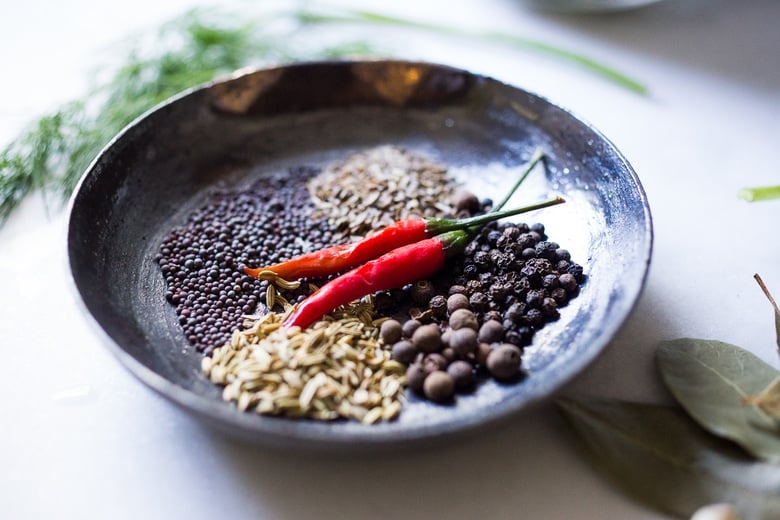
Step 2: Slice the garlic lengthwise and gather your spices.
Because these fermented pickles are left whole, you want the brine to be extra flavorful. I add a lot of garlic… 10-15 cloves, sometimes 20! Fermented Garlic is really good for the gut too!
Step 3: Place the spices on the bottom of the jar, then sliced garlic, fresh dill and bay leaves, and then add 2 layers of cucumbers, end on end, in a large two-quart jar (half-gallon). Press everything down.
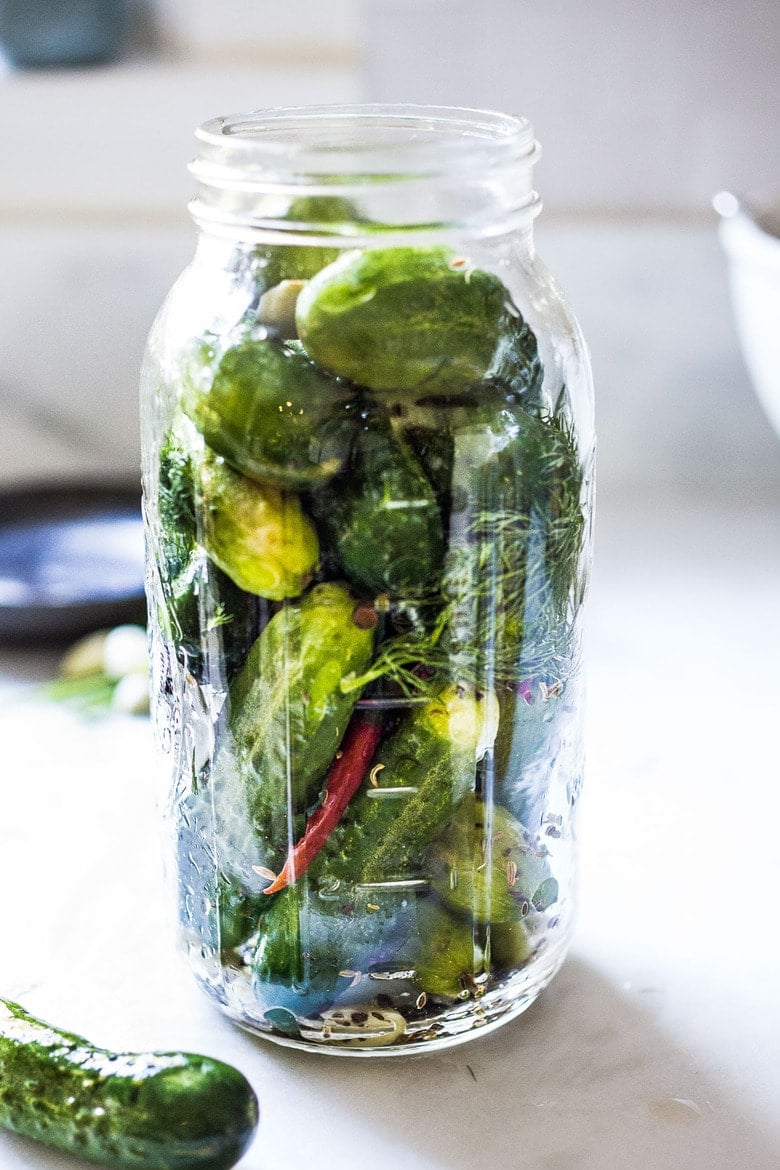
Step 4: Carefully measure and mix salt and water to create the 3% salt water brine- then pour this brine over the pickles leaving 1 1/2 inches of headroom.
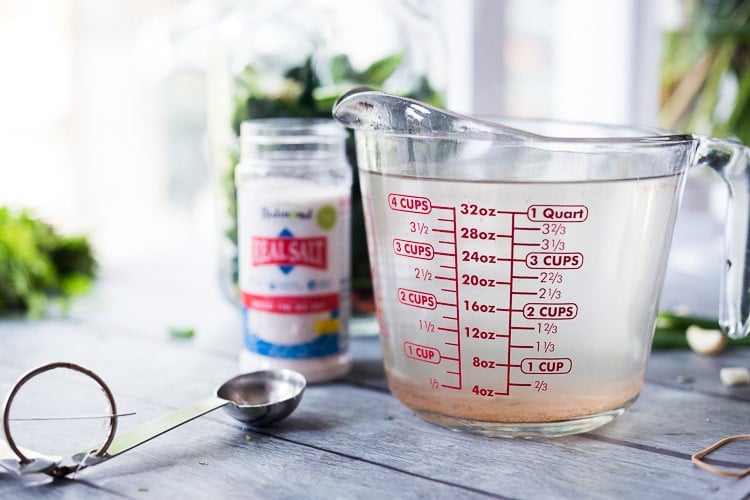
How salt works in fermentation:
- In a nutshell, using the right ratio of salt in fermentation encourages the growth of healthy bacteria while at the same time killing off bad bacteria. You want to be precise when measuring the salt and water in these kinds of recipes.
- Too much salt may kill off ALL of the bacteria -preventing fermentation.
- Too little salt will allow bad bacteria to keep on living. It is a fine balance. 😉
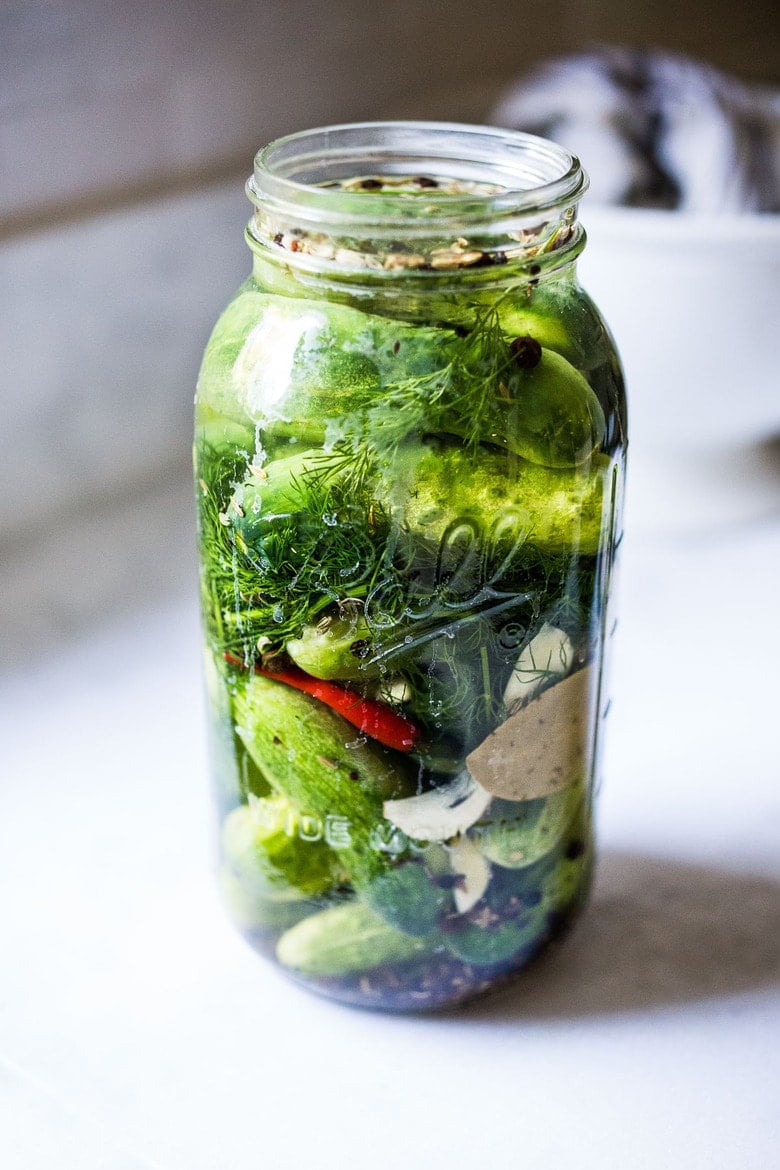
Step 5: Weigh down the cucumbers so they are completely submerged under the liquid, using a couple of fermentation weights, or a small zip lock bag filled with a little water (in a pinch).
MOLD: If the cucumbers or seeds are not submerged under the brine and become exposed to air- they can develop mold, so spoon any floaters out with a slotted spoon. Most seeds should stay submerged.
Step 6: Cover loosely with a lid or towel (to prevent bugs or flies from coming in, and to allow gases to escape) place in a bowl or pan to catch any overflow, and place in a cool dark place for 3-7 days, like the basement. You can also use and airlock lid- which allows air to escape, but nothing to fly in.
Step 7: Check after 2-3 days. Look for signs of life: bubbles/ or cloudy water. A cloudy brine is GOOD. Tap the jar and see if bubbles rise to the top. Check to see if any brine overflowed into the bowl ( both signs of life). This often takes about 3-5 days, I find 4 days is the “sweet spot”, depending on temperature. Cloudy brine is delicious and nutritious!
Step 8: Place the jar in the fridge to further slow the fermentation with a loose lid. They will continue to ferment very slowly and will keep indefinitely.
Expert Tips:
- Ferment at cooler temps (60-70F) to keep pickles crisp. If your home is hot, try placing in a cooler with ice. Take the temp of the brine.
- The longer you ferment them (unrefrigerated), the tangier they will get. But they will also get softer. I like them crisp, but you may want them tangier and softer. You can taste them at any point after you see bubbles.
- Smell: your ferment should smell tangy, garlic and fresh. If you notice anything foul or unpleasant, your ferment may have been contaminated: most commonly by dirty hands, dirty utensils, or a dirty jar.
- If you want to create a “fizzy” brine for drinking, tighten the lid, and burp daily if leaving out. You can tighten the lid in the fridge, but burp weekly. This will create a little pressure and give it some effervescence.
- Anything that touches air- may mold. Always fish out any floating spices with a slotted spoon to prevent this.
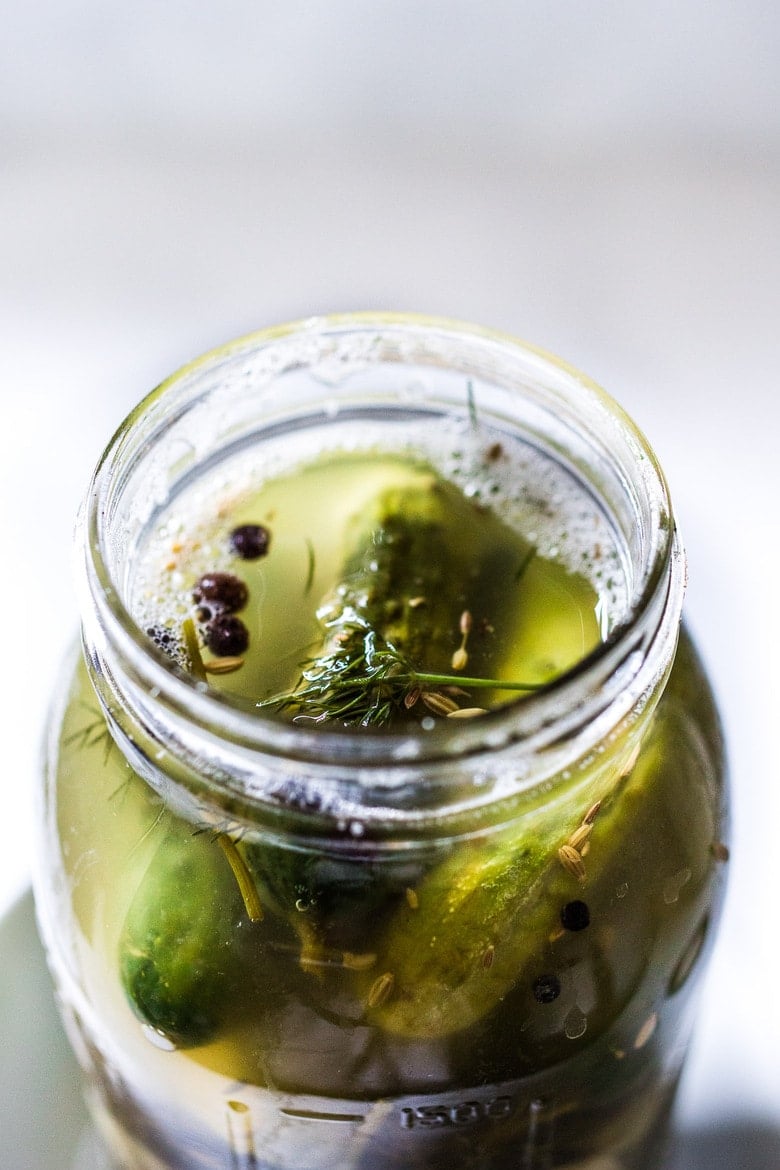
Once they are cold, give them a taste. They should be crunchy and flavorful! The brine is deliciously tangy, salty, and effervescent -so tasty and full of gut-supporting probiotics. The garlic is tasty too! Eat it!
I find myself often drinking shots of the brine! I also make this Gin & Brine Martini!
Let me know how you like this one in the comments below!
xoxoxo
More Favorite Ferments!
- Curtido & Cultured Salvadoran Slaw
- How to make Sauerkraut (Simple Cultured Cabbage)
- Beet and Cabbage Sauerkraut
- Cucumber Kimchi Pickles
- Turmeric Sauerkraut
How to make Fermented Pickles| 45-sec video
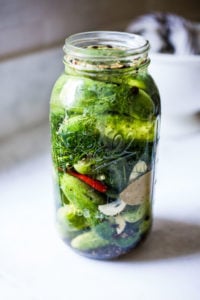
Homemade Pickles with Garlic and Dill
- Prep Time: 4 days
- Total Time: 4 days
- Yield: ½ gallon 1x
- Category: fermented, preserved
- Method: fermented
- Cuisine: American
- Diet: Vegan
Description
How to make Manhattan-style, fermented Dill Pickles! A simple recipe for making the most flavorful, crunchy, tangy, garlic dill pickles with only 15 minutes of hands-on time. Full of healthy, gut-healing probiotics these little guys are perfect as a low-calorie snack, or sliced and added to sandwiches.
Ingredients
- 2– 2 1/2 lbs pickling cucumbers– all similar size ( 5 inches)
- 5 cups filtered water or tap water (that is not overly chlorinated)
- 2 tablespoons fine sea salt or Himalayan salt — or basically one heaping teaspoon fine sea salt (7 grams) per one cup of water, for a 3% brine (see notes)
- 1/4 teaspoon turmeric (optional, adds a “fresh” flavor)
- 1 teaspoon each: fennel seeds, coriander seeds, allspice, peppercorns, dill seeds, mustard seeds, celery seeds- and feel free to add more peppercorns!
- 10–20 garlic cloves, sliced (or double for extra garlicky)
- 1/2 onion, thinly sliced (optional)
- big handful of fresh dill
- 1–3 fresh red chilies – or dried arbol chilies, or add chili flakes (all optional)
- 3–4 bay leaves (or a grape leaf or oakleaf) – these are sources of tannic acid to help them stay crisp.
You’ll need a 1/2 gallon mason jar, crock, or 2 quart-sized jars- clean and sterile.
Instructions
- Prep Cucumbers: Rinse the cucumbers, remove 1/16-inch of the flower end of each cucumber (keeps them from getting soft) and place them in an ice-water bath, to crisp them up (15-30 minutes). Leave them whole.
- Make the brine: Mix salt (2 tablespoons) and 5 cups cold water until dissolved.
- Wash your hands, jar and any utensils. No need to sterilize, just clean!
- Assemble: In a large, clean two-quart mason jar, place all the whole spices into the bottom. Add the dill, garlic and onions or turmeric if using. With clean hands, pack one layer of cucumbers tightly, standing on end, then add the bay leaves, then add the second layer of cucumbers standing on end.
- Press everything down, leaving 1 ½ inches of headroom. Pour the salt water brine over the top and weigh down the cucumbers with fermentation weights so they are submerged under the brine. Remove any spices that may have floated to the surface (which can mold).
- Cover the jar loosely with a lid or with a cloth- basically, the pickles will bubble and you want air to be able to escape.
- Place the jar in a pan or bowl to collect any overflow and leave it in a cool dark place (60-70F) for 2 -3 days (a basement, or lower kitchen cupboard) and check for bubbles or overflow, indicating fermentation. Half sour pickles will take 3-5 days with crisp, white interiors. If is colder than 65F, it may take longer, if hotter, they will ferment faster. Full sour pickles will take 14-21 days (see notes for a stronger saltwater ratio).
- After 2 days, check for signs of life: bubbles, overflow, or clouding. Tap the jar, and see if tiny bubbles rise to the top. I usually ferment for 3-5 days. Longer ferments will yield tangier pickles but will get softer as they ferment, and lose their vibrant color. Up to you. You can taste them at any point after you see bubbles, and ferment longer if you like. The brine will get cloudy as it ferments- this is a good sign! Once you see active bubbles, you can at this point place the jar in the fridge, where it will continue to ferment, but much more slowly. Keep the pickles submerged.
- Once chilled, give them taste. They should be crispy and flavorful with a little tang. (At this point, if you want a tangier or softer pickle, you can absolutely pull them back out again and ferment for a few more days longer if you want.)
- If you like fizzy brine, tighten the lid, burping every week or so or try using an airlock. If you don’t want to think about it, give the lid one loose twist, so it’s on there, but gases can escape.
Notes
If you need more brine, make sure you use the same ratio- 1 heaping teaspoon sea salt per one cup of water.
If using a grape leaf, place it on the side of the jar, then layer the remaining ingredients.
If pickles turn out too soft- it may be due to too warm of temperature during fermentation, or the flower end wasn’t removed (the flower end of the cucumber has enzymes that can soften pickles).
Feel free to use 2, quart-size jars, dividing cucumbers, spices and brine between the jars.
BRINE: This recipe is a 3% salt water brine, which is considered “safe”. It equals 7 grams of salt per one cup of water. I’ve had really good luck with this ratio – and this ratio allows me to drink the brine (like a shot) this is really healthy – full of good gut-supporting bacteria!
If you want a stronger, saltier brine, feel free to go up to 4.5%. For a full sour pickle (14-21 days) use a 4.5% brine.
- 3% ratio = 7 grams salt per 1 cup of water. (1 1/4 teaspoon fine sea salt, per 1 cup water)
- 3.5% Ratio= 9 grams of salt per 1 cup of water. (1 1/2 teaspoon fine sea salt, per 1 cup water)
- 4.5% ratio 10.8 grams of salt per 1 cup of water. (2 teaspoons per cup of water)
Cutting the Cucumbers: I recommend leaving them whole. The texture is much better. After your first successful batch, feel free to experiment.
Nutrition
- Serving Size:
- Calories: 16
- Sugar: 1.3 g
- Sodium: 297.4 mg
- Fat: 0.2 g
- Saturated Fat: 0 g
- Carbohydrates: 3.7 g
- Fiber: 0.5 g
- Protein: 0.7 g
- Cholesterol: 0 mg
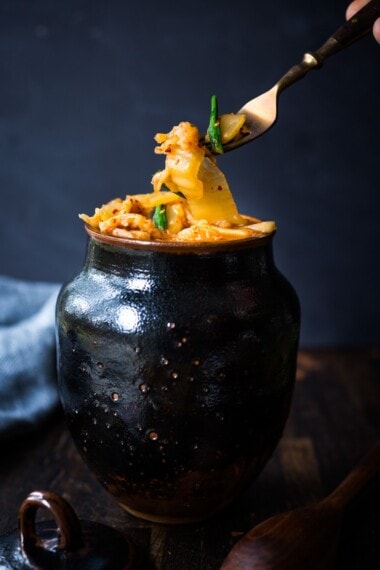
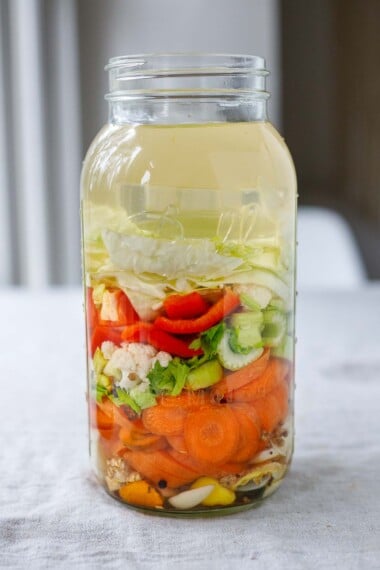
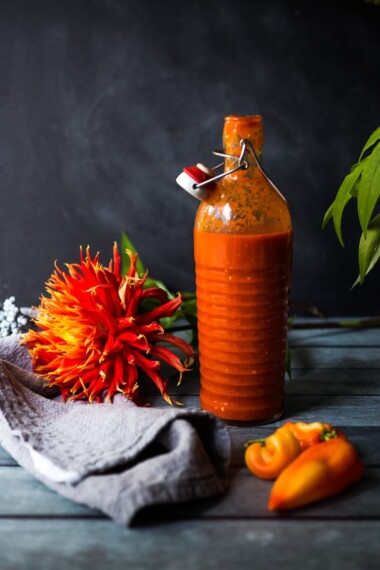
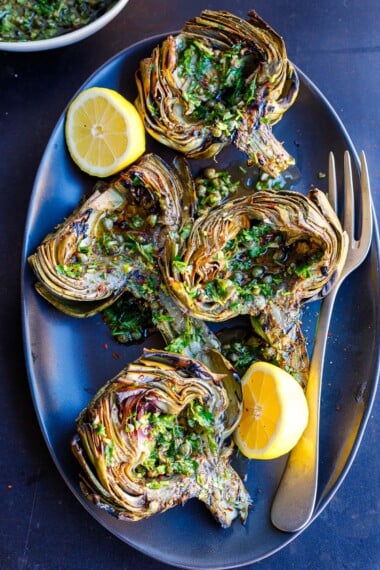
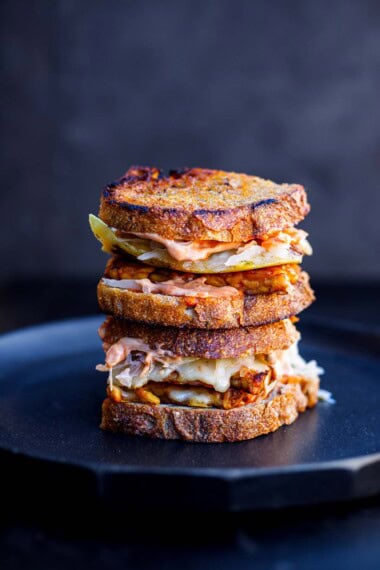
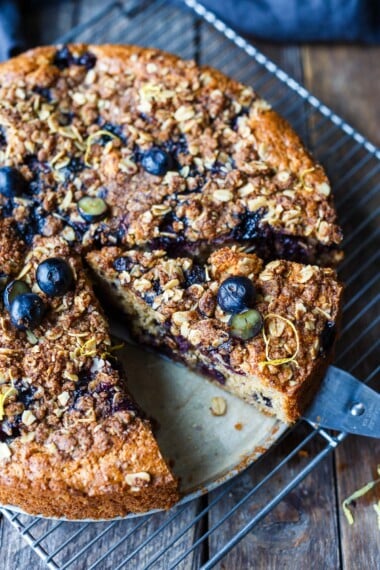
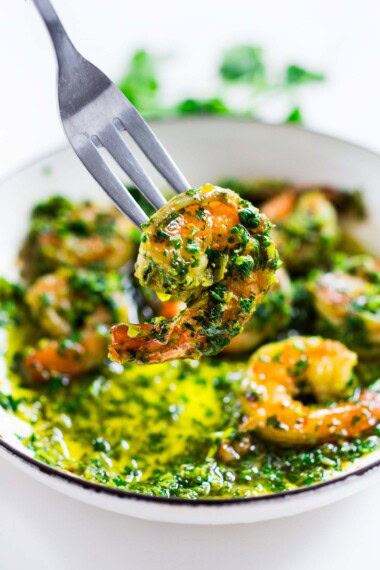
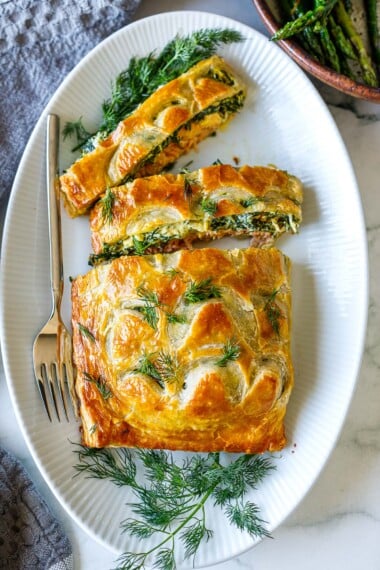
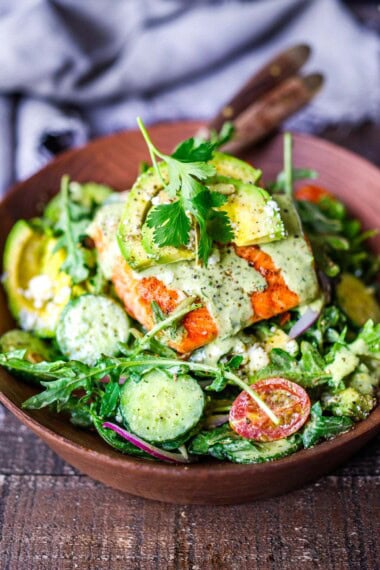
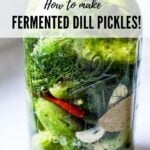
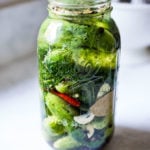
I made the pickles correctly but wound up with way too much liquid, enough for 3 qts and the jars weren’t even that full of pickles. One turned out ok but the others got a little funky, I think bc of not enough salt.
Hey Andrew- did you happen to weigh the pickles?
Different vegetables need different salt concentrations to prevent spoilage! The book that I have found to be most helpful in this is: https://www.amazon.com/gp/product/1579657184/ref=ppx_yo_dt_b_asin_title_o00_s00?ie=UTF8&psc=1
I make sauekraut and brine it for months. What is the longest I can safely brine pickles for?
I think it is the same, they too can go a long time, but will get soft and sourer with time. So not the crunchy lightly fermented Manhattan-style pickle you see here.
Hi….
Have been making pickles for years but never tried fermentation.So, when the proper cukes are available I will try them. Looking forward to the taste.
Brode in Etobicoke, Ontario
Hi Brode! Let me know what you think when you try them!
Hi again…
Do you cut off the flower end of the cuke as we do in regular dills?
Thanks…
Brode
Either way works- and I didn’t see a difference
This looks great – can’t wait to try. Thanks for beautiful and informative post! Cheers from Copenhagen.
Hi! Would I be able to use 4 pint size jars for this recipe?
sure!
I don’t have any mason jars so I am trying this using a new ziploc bag. I live in the tropics so will keep a beady eye on the fermentation. I excluded the air from the bag by submerging it in water first. The cucumbers are a Thai variety, very crispy when fresh and I just used whatever spices I had to hand, black and white peppercorns, bay leaves, fresh garlic and fresh birdseye chillies. I’ll let you know what happens.
…well, what happened? I bet you had to ‘burp’ the bag, eh?
Interesting! Please do!
Can i use the Persian mini cucumbers that I found at Sprouts? Also, did anyone comment on the crispness if the ends are trimmed? And, one more question….can I use “pickling spice” that I bought in bulk? It seems to have all the ingredients except the celery seeds and I can always add them, right?
I tried this with Persian Cucumbers and they got a little mushy/slimy. Of course, you are welome to try. Pickling spice is great!
Just got another case of quart Mason jars, for my next pickling adventure.
Note: when grape or bay leaves not avail., I have used white oak leaves (that have similar tannin strength).
For top weights I have used the cut-off bottoms of coffee shop cups to hold down jar contents below the brine. As the pickles are consumed, cup bottoms can be cut at longer heights from new cups.
Thanks again for the spoon measurements.
I have too many cucumbers in my garden. They are the smooth skin variety about 8 to 10 inches. So can I use other than pickling cucumbers?
I have not tried the smooth skin cucumbers so not sure how they would work.
I’d like to comment about your pickle making contribution. I’m so glad to see it.
I’m in my eighties and when I was a young boy, my Grandfather had a large garden. My Grandmother’s brother would drive over and make pickles in a barrel next to the garden. He put in alternate layers of pickles, dill, and NON-IODIZED salt. (Nothing else, and he probably knew how much salt for that size barrel) He sealed the barrel and then laid it on it’s side and placed it on a wooden rack. There was a small hole in the side of the barrel which is now on top. He filled the barrel with well water and then used something I will call a ‘hydrometer’ for lack of a better description. (I would think any hydrometer that measures specific gravity would work.) He would check the brine solution daily by floating the hydrometer in the hole and adjusting the brine by adding salt or water as needed. He left the hole open. The water would ooze out of the hole and run down the sides of the barrel. Us kids would stick our finger in the hole and taste the brine. It was great! The barrel was left outside in the open in central Minnesota summer weather until the pickles were ready. I’m sorry I don’t know how long, but it seemed like about two weeks. That is merely a guess. He then sold the whole batch to the cafe in town to use for hamburgers.
I absolutely loved reading this. Thanks for sharing. Beautiful!!!
Thanks for giving the exact ratio of salt and water .I have tried this receipe with fruit raw mangoes.
Oooooo fun!
Hi Sylvia,
Excited to try this recipe! Have made a few batches of sauerkraut and exploring more fermenting; love the option of pickles without vinegar.
I’m not able to find any “pickling cucumbers” near me at the moment. Can I use regular cucumbers cut into spears, or will they end up too mushy?
Thanks much – Deb 🙂
Well, I was just going to try that myself because the pickling cucumbers are out of season. My guess is the skin might get mushy… are you thinking thin-skinned like English or little Turkish?
Great recipe , very tasty!
Several +questions: Will these taste like the wonderful Klaussen pickles? Can I use the glass airlock fermenting tops to the Mason jars that I use to make sauerkraut? Can you suggest the best online sources for all the seeds needed in this recipe to insure freshness? Last of all, one of the comments mentions celery seeds, but I don’t see them in the recipe itself…how much is used?
Sorry about that, added to the recipe. All the seeds are linked to sources. Yes, the airlock should work great here. I think they come close to clausens. 🙂
I have been looking everywhere for Kirby cucumbers to use for fermenting but unfortunately, they are out of season at the moment. Would the fermenting still work if I used mini cucumbers as substitute? Thanks in advance!
They don’t turn out as crispy- but they do ferement. Just a little softer.
Just finished first batch, they came out great! Once done and at the texture I like which is right at 5 days, how do I store in the fridge? Just transfer entire batch in the brine? Will it cause them to get softer over time stored that way? If so, what other method of storing them in the fridge keeps the proper crunchiness? I’m thinking they will last one month max at our consumption rate.
Just place the whole jar with the brine and the pickles in the fridge. They will continue to ferment but at a much slower rate.
These pickles were delicious, I followed the recipe exactly, and left to ferment in the relatively cool basement for 5 days, with a very loose lid. I removed a bit of mold and the mold covered pickle from the top of the jar, and stuck the rest of the jar in the fridge. They were so fantastic that the entire one gallon jar was eaten in a week! Thanks for this yummy and easy recipe:)
Glad this worked for you!
If you can see actual mold ANYWHERE inside the jar, mold spores are ALL THROUGHOUT your ferment and it is unsafe to eat. Discard everything, sterilize everything and start over.
I’m suspecting you saw Kahm’s yeast (flat, whiteish film). Mold is fuzzy; Kahm is not. Kahm yeast will affect the flavor slightly, but it is not harmful.
Google “mold vs kahm” and I’m sure you’ll get tons of information and pictures.
Actually, finding ‘mold’ at the top of the jar does NOT mean it is throughout the jar. Mold requires dampness and oxygen to grow. It will not grow down in the oxygen starved salty brine. That is the reason they invented pickling foods thousands of years ago: to preserve and prevent mold and rot.
Now, when you find mold on your bread, that’s a different story…
Can I use this same recipe to pickle other vegetables? I don’t see why not, but thought I would ask! I was planning on pickling some green beans as well as cukes and would like to make one recipe.
I don’t see why not?? Give it a go!
Can you re-use the brine?
There is debate about this out there. Some say yes, some say not to. I have tried, with not great results. 😉
You can use it to start new batches of pickles but the brine will be diluted since it extracted water from the original cucumbers 🙂
Hi, I am in the middle of doing this but just noticed that I don’t have bay or grape leaves. Are they necessary?
No- not imperative. You can always add bay leaves in the next few days, after you start fermenting.
Hi, just a minor nitpick, but you have celery seeds listed in the body of the recipe, however you don’t have them in the summary ingredients below.
Thanks!
I added them, thanks!
This is an old recipe my Dad used to make dills when I was a kid, some 70 years ago and I’ve been using it for years and 3 days ago my son and I made a batch for him and was able to helped him with. Just a quick question, after fermenting for 4 days with loose lid, can you just crank down the lids tightly and store jars in the basement along with my other canning, until you want another jar of pickles. Would you also sterilize the lids before tightening them, I never had but just asking.
Because they are fermenting and will continue to ferment, if you crank down on the lids without refigerating, they could actually explode because they are bubbling. So best to keep these kind in the fridge.
Feeling a little silly to have this question and maybe I overlooked it but do you take out the garlic, Dill, Etc out of the brine before you put it in the refrigerator? Or does it always stay with the pickles? The recipe sounds delicious
Keep them in! 🙂 Not silly at all!
hello! in the middle of doing your recipe – looking forward to the results. Wondering if you have ever trimmed the ends of your cukes? I have read this helps them to stay crispier….I just came across this info so will try with my last jar…
I haven’t but please let me know- super curious!
Join us if you love pickles! https://www.facebook.com/groups/2398069970486700/?ref=share
Oh dear. Sorry about that James. Sounds like the fermentation may not have occurred. Any more clues as to what could have gone wrong?
Fridge too cold, perhaps? It was the only place I could put the big bottle. All I know is that I can not afford to risk trying again.
Appreciate you getting back to me James. Can you tell me how long you fermented before putting in the fridge and what the temp was (on average)? Did you see bubbles or clouding before refrigerating? Thanks, jsut trying to figure this mystery out.
I had bubbles in 3 days and put it in the fridge that day. I believe it was around 70°F in the basement. I have no idea what the fridge temperature was, but probably around 33 or 34. I hope my pickles didn’t start to freeze.
Ok that is interesting. Sounds like it did ferment though. Sometimes when it is warmer like that- the pickles just don’t turn out as well. 55-65F is ideal. The cold fridge may have slowed the fermentation, but it shouldn’t have killed it. If you do ever try this again- I would check the temp of the fermenting jar with a food thermometer. Sometimes it is just as simple as finding a cooler spot and moving it.
Replies no longer appearing.
Hi James, comments are moderated, so there is up to a 12-24 hour delay in their posting. 🙂 I responded to your latest post below. 🙂
Sadly, that 70° basement is probably the coolest place I have in the summer, when the cucumbers are available. Oh well… I tried.
I’m sorry it didnt work this time.